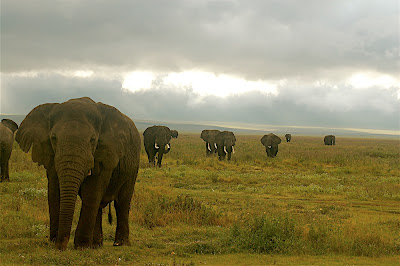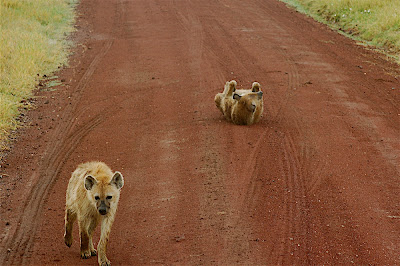
The fifth, and final day, of my Tanzanian safari got off to an auspicious start. We were camped on the rim of the Ngorongoro Crater the night before, and were up before dawn once more to begin our trip down into the crater. However, that morning we awoke to torrential down pours. The rain came in buckets and we took shelter in one of the permanent shelters at the campsite to wait out the storm.
April is considered the "Rainy Season" in Tanzania, but up until that morning, we had been spared the worst of the rain. While on Kilimanjaro there were late afternoon rains nearly every day, but while on safari, we only had rain on one day. But that morning, we saw what the rainy season was really all about. It poured very hard for a good 20 or 25 minutes, and as it finally began to slow down, we darted for the truck so we could begin our descent into the greater.
When we arrived at the gate for the crater, it wasn't open just yet. We were the first to go down that morning, and while the rains began to dissipate, there was still a great deal of mist in the air, making it difficult to see down into the crater itself. The narrow road leading down was bumpy and slick with moisture, and since it drops more than 2000 feet to the crater floor, it wasn't long before we has an impressive wall to one side of us, and an impressive drop off into the mist on the other.
When we reached the crater floor and began our game drive, with the mists falling away above us, and eventually dissipating altogether. It wasn't long before the warm equatorial sun was shining down upon us, and brightening the crater itself. Ngorongoro is the largest unbroken caldera in the World and has an area of 260km. The area, which is a World Heritage site, was formed when the cone of a huge volcano collapsed millions of years ago. Now, it's a completley contained ecosystem with an abundance of wildelife.
At first, we mostly saw animals that we had seen on the Serengeti, such as buffalo and impalas. But it wasn't long before we began to see some unusual and very cool sights. One of the first of these sights for that day, were a couple of hyenas moving through the scrub grass. We had seen hyenas before on the Serengeti, but these moved together onto the road in front of us, then came right along side the truck. One even glanced up at me in the window as he sulked on by, no more than a few feet from me.

A little further down the road, we came across a female black rhino and her baby. The black rhino is an extremely rare site, as they have been on the endangered species list for years. Ngorongoro Crater is one of the last places on Earth where the can be seen, and we were fortunate it enough to see these two. We would see no others during our time in the crater.
As we drove around that morning, we spotted all manner of creatures. A large flock of ostriches strutted throug the grass of one area, while a small group of hippos waded in a muddy pond. We spotted a few lions here and there, but always from a distance, as they seemed more wary than some that we saw on plains. We came across a very large herd of wildebeest, several thousand strong, and a group of a dozen elephants, most with very impressive tusks. All the while, the walls of the crater reminded us that all of this was contained in one very impressive place.
Not everything was cheery in the crater however. As the morning wore on, we began to notice more and more safari vehicles on the road. They would bunch up in large numbers in areas where a lion could be seen or some other rare animal. In some spots, as many as a dozen or more Land Cruisers were stopped along the road. All those vehicles caused traffic jams, and made the crater seem very crowded. Much different than the wide open spaces of the Serengeti. Now mind you, this was during the "low season", I can only imagine what it msut be like there during the high season, when the amount of visitors is many times more than when I visited.

As our game drive came to an end, we made our way to the only road leading out of the crater. It was even more narrow, twisty, and rough than the one that lead down to the crater floor. The forests were thick along side the road, and it was like something out of a movie, reminding me of scenes from Romancing The Stone, as we drove up, leaving Ngorongoro behind us.
We returned to our campsite and had a late breakfast/early lunch. Then, we loaded up the truck, and were on the road back to Arusha. Soon we made our way back through the gates of the Ngorongoro Crater Conservation Area, and ontop pavement once more. The first paved road we had seen in more than three days. The drive back to Arusha would take several hours, and after five amazing days, our safari was at an end.
Obviously, this was an incredible adventure, and one that I would recommend it to anyone who has an interest in travel and exploring the legendary Serengeti. It was everything you could hope for and so much more, with the most diverse wildlife to be found anywhere on the planet. I would also highly recommend Duma Explorer for your Kili climb or Safari adventures. They were wonderful to work with in every way, and were very accomidating at every step. Their guides, cooks, and porters are amongst the best anywhere, and their prices are very reasonable. If you're planning a trip to Tanzania, you should definitely consider contacting them.
Finally, I would like to thank Colm, Mike, and Ressie, my companions on this trip. While it was amazing from start to finish, I can't imagine three better people to share this adventure with. When we met, we were four people looking for a similar travel experience but when we parted ways, we were friends who had bonded far more than I could have expected or hoped for in that time period. I shall never forget the time we spent together, and I hope that we have more adventures together in the future.
No comments:
Post a Comment